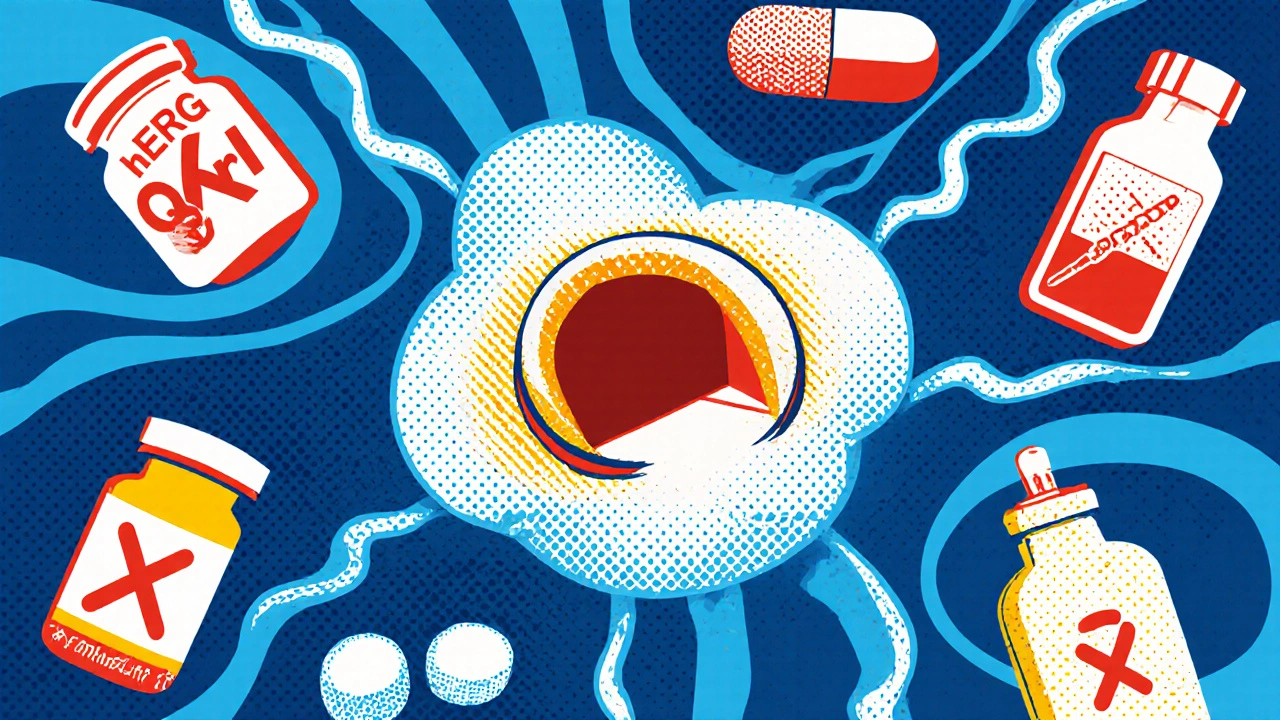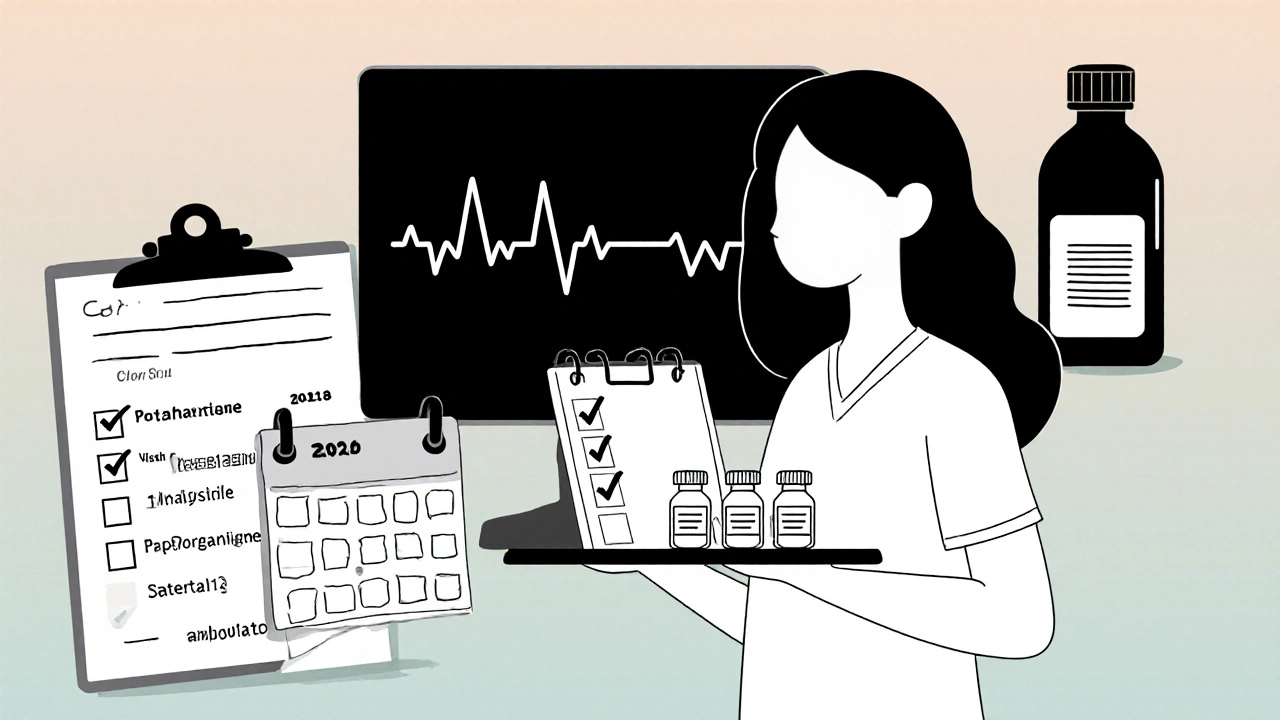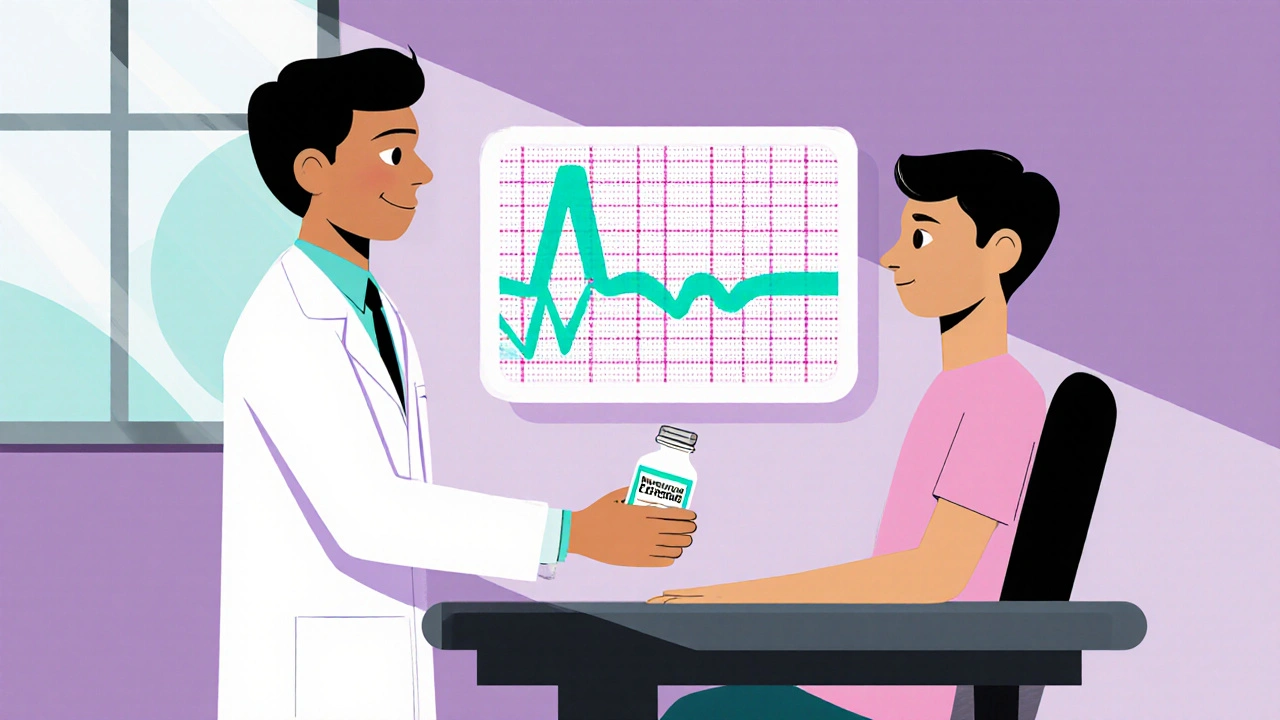Methadone and QT-Prolonging Drugs: How Combined Use Raises Arrhythmia Risk
Why this matters
When doctors prescribe Methadone a long‑acting opioid used for dependence treatment and chronic pain, they are often focused on withdrawal relief and dose stability. What many patients don’t realize is that methadone can stretch the heart’s electrical repolarisation window, especially when it’s paired with other drugs that also delay the QT interval. The result can be a potentially deadly rhythm called torsades de pointes (TdP).
Methadone QT prolongation isn’t just a lab curiosity; it’s a real safety issue that shows up in emergency rooms, forensic reports, and regulatory warnings worldwide.
What is QT interval prolongation?
QT interval prolongation an elongation of the heart’s electrical recovery phase measured on an ECG occurs when the time between ventricular depolarisation (Q) and repolarisation (T) exceeds normal limits - >430 ms for men and >450 ms for women. A borderline length (431‑450 ms for men, 451‑470 ms for women) flags a warning, while >500 ms is the danger zone where TdP becomes a credible threat.
How methadone messes with the heart’s ion channels
The classic story points to methadone’s blockade of the hERG channel the rapidly activating delayed‑rectifier potassium current (IKr) channel responsible for cardiac repolarisation. By plugging IKr, methadone slows the final phase of repolarisation, lengthening QTc.
Recent research (JAHA 2022) adds a twist: methadone also dampens the inward‑rectifier potassium current (IK1 a current that stabilises the resting membrane potential in cardiac cells). Dual‑channel inhibition creates a “perfect storm” - the cell’s membrane becomes unstable and prone to delayed after‑depolarisations, both of which set the stage for TdP.
In practical terms, a typical 100 mg/day dose raises QTc by about 10‑12 ms on average. Over weeks of therapy, the increase can climb to 20‑30 ms, especially in patients with other risk factors.
Dose matters, but it’s not the whole story
Data from the Wedam et al. (2007) cohort shows that QTc >500 ms is seldom seen at doses below 100 mg/day, yet the same study flags a 1.3‑16 % prevalence of dangerous prolongation across all dose ranges. The takeaway? Even modest methadone regimens can become risky when other QT‑prolonging agents enter the mix.
Key numbers to keep in mind:
- Baseline normal QTc: ≤430 ms (men), ≤450 ms (women)
- Borderline: 431‑450 ms (men), 451‑470 ms (women)
- High‑risk threshold: >500 ms or an increase >60 ms from baseline
Risk escalates sharply when the QTc climbs above 470 ms in women or 450 ms in men - clinicians should act before the next ECG.

When methadone meets other QT‑prolonging drugs
Imagine you’re treating a patient with methadone who also needs an antibiotic for a lung infection. That’s where the additive danger spikes. The FDA’s 2006 black‑box warning explicitly notes that co‑prescribing multiple QT‑prolonging agents multiplies TdP likelihood.
Common culprits include:
- Macrolide antibiotics e.g., erythromycin, clarithromycin - known for hERG blockade
- Fluoroquinolones e.g., moxifloxacin - prolong QT via multiple ionic pathways
- Antifungals such as fluconazole
- Psychotropics: haloperidol, citalopram, venlafaxine
- Protease inhibitor ritonavir (CYP3A4 inhibitor that raises methadone levels) - Ritonavir an HIV medication that both blocks QT and impairs methadone metabolism
- Recreational drugs like cocaine - short‑acting but can still trigger QT spikes
Case reports from Sweden and New Zealand illustrate the danger: patients on methadone plus a macrolide developed QTc >500 ms and suffered TdP; dose reduction alone didn’t help until the interacting drug was stopped.
Clinical monitoring - what every prescriber should do
Guidelines now call for a baseline ECG before starting methadone, a repeat after dose stabilisation (usually 1‑2 weeks), and periodic checks thereafter. High‑risk patients (known long QT syndrome, structural heart disease, electrolyte disturbances, or any QT‑prolonging co‑medication) need ECGs every month or more often.
When a QTc >450 ms in men or >470 ms in women is observed, the next steps are:
- Confirm the reading (repeat ECG, correct for heart rate)
- Check electrolytes - replace potassium < 3.5 mmol/L or magnesium < 0.7 mmol/L
- Review all meds - pause or switch any non‑essential QT‑prolonging agents
- If QTc >500 ms or rise >60 ms, consider dose reduction, switch to buprenorphine, or temporary discontinuation
Switching to buprenorphine is often safe: its hERG blockade is >100‑fold lower than methadone, meaning QT effects are negligible at therapeutic doses.
Comparison of common opioid maintenance options
| Drug | Typical dose range | hERG block (relative) | Avg. QTc increase (ms) | Key advantages |
|---|---|---|---|---|
| Methadone | 20‑200 mg/day | High (baseline) | ≈10‑12 (baseline) - up to 30 ms with high dose + interactions | Strong opioid effect, flexible dosing, proven mortality reduction |
| Buprenorphine | 4‑24 mg/day | Very low | ≤2 ms (clinically insignificant) | Ceiling effect reduces overdose risk, easier office‑based prescribing |
| Levomethadyl | 300‑600 mg/day | Similar to methadone | ≈10‑15 ms | Long‑acting, less popular now, similar efficacy to methadone |
When the goal is to minimise cardiac risk, buprenorphine is the clear front‑runner. That said, methadone still wins for patients needing higher opioid potency or who have already stabilised on it.

Practical checklist for clinicians
- Take a full medication history - flag any known QT‑prolonging drugs.
- Obtain a baseline ECG and repeat after the initial dose titration.
- Screen electrolytes; correct K⁺ < 4.0 mmol/L or Mg²⁺ < 0.8 mmol/L before starting.
- Document QTc values and set action thresholds (>450 ms men, >470 ms women).
- If multiple QT‑prolonging agents are unavoidable, consider a lower methadone target (<80 mg/day) and increase ECG frequency.
- Educate patients to report palpitations, syncope, or dizziness immediately.
- Maintain a log of dose changes, ECG dates, and any co‑medication adjustments.
What the future may hold
Newer electrophysiology studies are exploring U‑wave integral analysis as a way to detect early loss of repolarisation reserve-something that could flag risk before QTc even crosses the borderline. If validated, such tools might let clinicians keep patients on methadone safely while still catching dangerous interactions early.
Meanwhile, regulatory agencies continue to tighten prescribing guidelines. In the United Kingdom, the NHS now requires a formal cardiac risk assessment for any methadone dose >100 mg/day, echoing the FDA’s earlier warnings.
Bottom line: methadone remains a vital medication for opioid dependence, but its use demands vigilant cardiac monitoring, especially when other QT‑prolonging drugs are on board.
Frequently Asked Questions
How long does it take for methadone to affect the QT interval?
Most patients see a measurable QTc rise within 1‑2 weeks of reaching a stable dose, but the effect can continue to grow over several months, especially if the dose is increased.
Can I take a short‑acting antibiotic like azithromycin with methadone?
Azithromycin does have QT‑prolonging potential, so it should be avoided if possible. If an alternative is unavailable, keep the methadone dose low, correct electrolytes, and obtain an ECG before and after the antibiotic course.
Is a QTc of 470 ms always a reason to stop methadone?
Not automatically. A QTc of 470 ms in a woman (or 450 ms in a man) triggers a detailed review-check electrolytes, look for interacting meds, and consider dose reduction or a switch to buprenorphine.
Do women have a higher risk of TdP on methadone?
Women generally have a longer baseline QTc, so the same absolute QTc value puts them closer to the high‑risk zone. Clinicians often use a lower threshold for action in female patients.
What electrolyte abnormalities are most concerning?
Hypokalemia (<3.5 mmol/L) and hypomagnesemia (<0.7 mmol/L) both magnify hERG blockade. Repleting potassium and magnesium can lower QTc by 5‑10 ms in susceptible patients.






13 Comments
Pamela Clark
October 25 2025Methadone blocks hERG channels, so it lengthens QT, and that’s apparently the plot twist everyone loves.
Diane Holding
October 29 2025When you add a macrolide, you’re basically stacking two QT‑prolonging agents, so a baseline ECG and electrolyte check become non‑negotiable.
Manish Verma
November 1 2025Australia’s guidelines already flag this combo, yet clinicians keep ignoring the simple math: dose plus other drugs equals higher risk, and that’s unacceptable.
Lionel du Plessis
November 5 2025hERG inhibition + IK1 dampening = destabilised myocardial repolarisation leading to early after‑depols and TdP risk skyrockets
Greg Galivan
November 8 2025That’s the point – you can’t pretend the numbers don’t add up, the ECG reflects the physics.
ALBERT HENDERSHOT JR.
November 11 2025It is essential for prescribers to adopt a systematic monitoring protocol, beginning with a pre‑treatment ECG and followed by periodic assessments to catch any QTc drift before it becomes hazardous.
Donal Hinely
November 15 2025Think of methadone as the spicy salsa in a cardiac cocktail – a little can kick up the flavor, but too much mixed with other hot sauces will set your heart on fire.
christine badilla
November 18 2025I swear, watching a QTc creep past 500 ms feels like the universe flashing a neon “STOP” sign right in front of a patient’s ribcage!
Andrae Powel
November 22 2025Patients often feel powerless when they hear about TdP, so reassuring them with clear steps – electrolyte correction, med review, and ECG follow‑up – can restore confidence.
Leanne Henderson
November 25 2025Wow!!! This checklist is thorough!!! It really helps clinicians stay on track!!!
Suzanne Carawan
November 29 2025Sure, because adding more exclamation points magically reduces the incidence of torsades.
eko lennon
December 2 2025Picture this: a patient walks into the clinic, methadone dose stable, feeling optimistic about recovery. The clinician, however, remembers the silent menace lurking behind the prescription – the QT interval, a fickle barometer of cardiac electrophysiology. It starts with a modest 10‑12 ms bump, almost invisible, like a whisper in a crowded room. Days turn into weeks, the dose nudges upward, and that whisper grows into a murmuring warning. Add a macrolide for a lingering cough, and suddenly the heart’s repolarisation landscape is riddled with potholes. The hERG channels, already throttled by methadone, encounter a new antagonist, amplifying the block. Meanwhile, the IK1 current is silenced, stripping the cardiac cells of their stabilising anchor. Electrolytes begin to shift – potassium drops, magnesium dips – each electrolyte dip acting like a loose screw in a delicate machine. The ECG, that humble strip of paper, now shows a QTc flirting with the dangerous 470‑500 ms zone. Clinicians, tempted to ignore the numbers, may think “it’s just a number”. But torsades de pointes doesn’t ask for permission; it strikes without warning, a chaotic flutter that can topple the patient. The emergency department rushes in, defibrillators humming, as the heart’s rhythm spirals into chaos. After the storm, the story repeats: methadone dose reduced, the interacting drug discontinued, electrolytes re‑balanced, and the QTc finally settles back into safer territory. This cycle, repeated across countless charts, underscores a simple truth: vigilance beats bravado every time. So, before you write that next prescription, pause, check the baseline, review the med list, and remember the heart’s quiet warning signs before they become a loud scream.
Sunita Basnet
December 6 2025Stay proactive, correct electrolytes, monitor QTc and keep patients safe